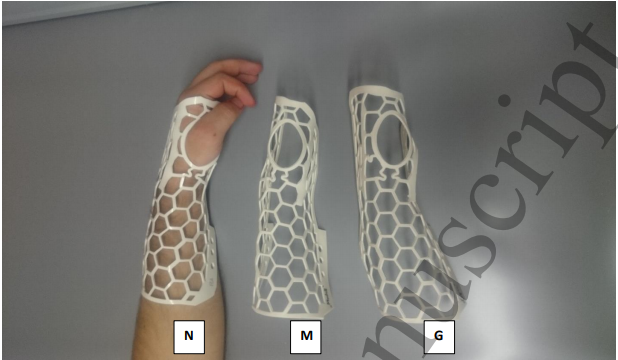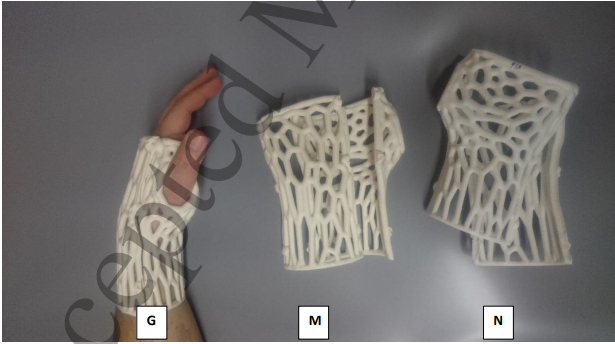In a paper entitled “Novel PLA-CaCO3 Composites in Additive Manufacturing of Upper Limb Casts and Orthotics—A Feasibility Study,” a group of researchers looks at 3D printing to treat upper limb injuries, which are, they say, “among the most common injuries worldwide.” While bone fractures are traditionally treated with plaster casts, new treatments have been used experimentally, including 3D printing to create a cast personalized to the patient’s needs.
The researchers tested three different materials’ potential for use in 3D printed casts; two of those materials were new. They used unique filaments from Hungarian company Filamania. These composite materials were compared to standard PLA polymers. The composites were made from PLA mixed with fine CaCO3 powder. First made by designer Carmen Brio a few years ago this type of material has interesting properties.
“The ‘PLA Modell’ (M): contained 20 m/m% of CaCO3 and ‘PLA Gypsum’ (G) 50 m/m% of CaCO3,” the researchers explain.
Mechanical tests were performed on the materials, including a Charpy Impact Test, a three-point bending test, tensile strength test and Shore D hardness test. The researchers then investigated the materials in terms of possible production for splints or casts. First they examined thermoforming, then 3D scanned a healthy volunteer’s hand to create a CAD model, which was then 3D printed.
The researchers found that 3D scanning and 3D printing was more costly and time-consuming than thermoforming; however, the 3D technology resulted in a better fit. The volunteer stated that the 3D printed cast provided more stability, which is critical for healing. While 3D printing is more expensive than traditional plaster cast methods, the researchers state, the costs are getting closer.
With the addition of CaCO3 to the PLA, the materials’ dynamic and static properties were altered significantly. Namely, they became more rigid and brittle. They were very easy to thermoform, however, as well as to 3D print, and they were easily obtained, making them good candidates for the production of casts and splints.
“The static tests and Shore D measurements indicate that the materials can be also used for medical modelling (for example: bone models for IO – intraousseous cannulation – trainers, teeth models for skills training, and individualized training of bone synthesis procedures),” the researchers conclude. “Our recent study– analysing the thermal behaviour of these materials – have shown that these materials are suitable for disinfection procedures also, which is an important feature in clinical applications. For long-term results, clinical, patient-related studies have to be carried out in the near future, along with detailed market research, focusing on IP (intellectual property) relations also.”
The researchers point out that one drawback of 3D printing is its typically slow speed; waiting in the emergency room for 19 hours for a cast to be ready is not an option. However, using a temporary cast until a better one can be 3D printed is a possibility, and the researchers anticipate that 3D printing speeds will soon evolve to an acceptable range. In terms of 3D scanning, while the researchers were able to use a healthy individual to create a model, most patients with fractures will need to have their opposite limb scanned to create a proper fit.
Authors of the paper include Péter Varga, Denes Lorinczy, Luca Tóth, Atilla Pentek, Miklos Nyitrai and Peter Maroti.
Discuss this and other 3D printing topics at 3DPrintBoard.com or share your thoughts below.
Subscribe to Our Email Newsletter
Stay up-to-date on all the latest news from the 3D printing industry and receive information and offers from third party vendors.
You May Also Like
Gorilla Sports GE’s First 3D Printed Titanium Cast
How do you help a gorilla with a broken arm? Sounds like the start of a bad joke a zookeeper might tell, but it’s an actual dilemma recently faced by...
Nylon 3D Printed Parts Made More Functional with Coatings & Colors
Parts 3D printed from polyamide (PA, Nylon) 12 using powder bed fusion (PBF) are a mainstay in the additive manufacturing (AM) industry. While post-finishing processes have improved the porosity of...
$25M to Back Sintavia’s Largest Expansion of Metal 3D Printing Capacity Since 2019
Sintavia, the digital manufacturing company specializing in mission-critical parts for strategic sectors, announced a $25 million investment to increase its production capacity, the largest expansion to its operations since 2019....
Velo3D Initiates Public Offering in a Bid to Strengthen Financial Foundations and Drive Future Growth
Velo3D (NYSE: VLD) has been among a number of publicly traded 3D printing firms that have attempted to weather the current macroeconomic climate. After posting a challenging financial report for 2023,...


































